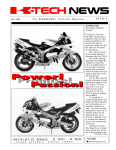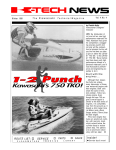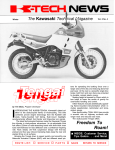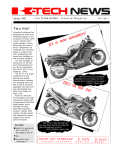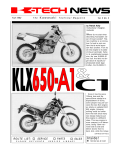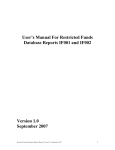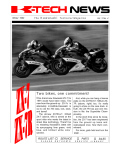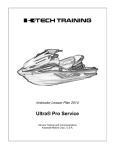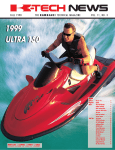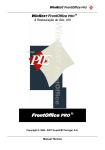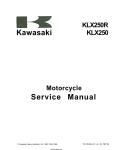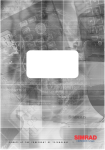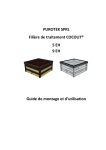Download K-Tech News Vol.3 No.1
Transcript
Spring 1989 The Kawasaki Technical Magazine Vol. 2 No. 1 Service Tip Contest TECHNICIANS, ENTER NOW! K-TECH NEWS is a magazine dedicated to providing Kawasaki Dealer technicians with technical service tips. Tips that will save you time and make you money. These tips come from the Hot Line Specialists, Technical Training classes, and from YOU! To make it easy for you to submit your tips and suggestions, we’ve provided a pre-addressed, postagepaid Service Tips form. Just fill in the blanks, fold and tape the page and mail it to us. If we print your suggestion, you will be awarded $50.00 CASH!!! Duplicate suggestions may happen, so mail in your tip early. To submit suggestions from more than one person in your shop, photocopy a Service Tips Form and mail it in separately. Credit will be awarded based on KMC’s technical staff’s evaluation and your promptness in sending in your tip. The only other qualification is that you MUST be employed by an authorized Kawasaki dealership. The feature article on page five continues our series on turning your service department into a successful service operation. An overview of the K-BOSS service system will lead you through proven methods of controlling and operating your service department. The service merchandising article on page six gives you tips on developing a service menu, selling services and taking care of new customers. All of which result in higher customer satisfaction and higher service profits. Remember to file each issue of K-TECH NEWS in your Service and Warranty binder under the ‘Training Bulletins” tab. If you need more copies or back issues, just call the Hot Line or your Technical Training Instructor. FIRST THE ZX-10, AND NOW THE ZX-7 Just as the Ninja 1000 was father to the ZX-10, the Ninja 750 sires the incredible ZX-7. The engine is lighter and more powerful, with an all-new cylinder head sporting downdraft carburetors feeding intake ports that shoot straight into the 11.3:1 combustion chambers. The one-piece, forged crankshaft is almost two pounds lighter for even quicker revving. Quiet power is the goal of the ultra-light, 4-into-2-into-1 exhaust system. The front fork tubes are huge: 43mm in diamerter; and feature cartridge-type construction. The result is razor-sharp handling under the most adverse conditions. Preload and damping are adjustable. The Uni-Trak shock absorber is gas-charged to prevent shock fluid aeration, and controls an extra rigid, braced swingarm. The rear suspension has adjustable preload and rebound damping The new front brakes have Balanced Action Calipers with not two, but four pistons per caliper, damping onto full-floating, stainless steel discs on aluminum carriers. Radial tires complete this racy-looking . . . and performing . . . package! SPECIFICATIONS Displacement . . . . . . . . . . . . . . . . . . . . . . . . . . . . . . . . . . . . . . . . 748 cc Sore&Stroke . . . . . . . . . . . . . . . . . . . . . . . . . . . . . . . . . 68.0 x 51.5mm Compression Ratio . . . . . . . . . . . . . . . . . . . . . . . . . . . . . . . . . . . . . 11.3:1 Max. Horse Power . . . . . . . . . . . . . . . . . . . . . . . . . . . . 107 @ 10,500 rpm Max. Torque . . . . . . . . . . . . . . . . . . . . . . . . . . . . . . 58 ft-lb. @ 9,500 rpm Carburetor . . . . . . . . . . . . . . . . . . . . . . . . . . . . . . . . Keihin CDK-D 36 x 4 Front Tire Size . . . . . . . . . . . . . . . . . . . . . . . . . . . . . . . . . . .120/70 VR-17 Rear Tire Size . . . . . . . . . . . . . . . . . . . . . . . . . . . . . . . . . . . 170/60 VR-17 Wheelbase . . . . . . . . . . . . . . . . . . . . . . . . . . . . . . . . . . . . . . . . . . 57.3 in. Fuel Tank Capacity . . . . . . . . . . . . . . . . . . . . . . . . . . . . . . . . . . . . 4.7 gal. Seat Height . . . . . . . . . . . . . . . . . . . . . . . . . . . . . . . . . . . . . . . . . . 30.3 in. NOTE: Specifications subject to change without notice. ROUTE LIST: o SERVICE MGR o PARTS o SALES RETURN TO SERVICE The Technical Magazine l 1 SHOP TALK/ TECHNICAL Kawasaki Integrated Power-Valve System by Ken Ploeser Enduro KIPS? You bet! Making something better than the best is what we at Kawasaki are very good at. That’s exactly what we did to the KDX200-E1. We took the KIPS technology from the KX125-F1 and applied it to the mild port timing inherent in the KDX’s enduro engine. This makes for a very strong low end while adding just the right amount to top-end horsepower. Technically speaking, the KlPS valves are basically the same as those used in the KX125F1. There are three valves. Two are located adjacent to the exhaust port and connect to exhaust sub-ports. The resonance chamber connects to the left side KlPS valve port. The third valve is located at the top of the exhaust port. This is what changes the exhaust duration for more top end horsepower. The shape and size of the KlPS port allows just the right exhaust gas flow without causing radical peaks in the horsepower curve. The guys at Team Green tell me there have been no problems with the KlPS valves at all. The only thing that needs attention is that a top end inspection and decarboning job should be performed on a regular basis. The interval depends greatly on the brand of two stroke oil and of course the mix ratio. Kawasaki recommends Kawasaki two stroke race oil, (P/N K61020-022A) at a mix ratio of 32:1. If the customer is following these recommendations, you can suggest that decarbon work be done as frequently as the top end is disassembled for inspection. This means the customer should be advised of the periodic maintenance chart in the owners manual. The chart indicates inspection should be performed every 1000 Km or 621 miles of operation. Offer a service special for this job. Contact every customer that bought a KX or KDX from your store in the last 90 days. Go back to the service files to get more names to contact. Here’s a tip: Have all KX and KDX customers put their names on your “preferred customer” list when they have any work done. That way you have a list of customers who expect you to contact them in the near future. 2 K-Tech News l KDX200-E1 KIPS 1. Exhaust Valves 2. Idle Gear 3. Punch Mark 4. Guide 5. Main Exhaust Valve COMMUNICATIONS MICRO- by “Micro” Mike Jeffers, Parts Publications We have just finished producing roughly 75 new microfiche for 1989. included are the new KX’s, the liquid cooled KDX200-E1, and the JB650-A1:JET MATE. Because of the constant updating of parts and service information it’s essential to have a Micro-K update subscription. Each microfiche covering the ’88 and ’89 model years has been updated to include all service, parts and racing bulletins that have been released. The bulletins are found on row “N”, and are extremely helpful in checking any FDM’s, FAR’s or RECALLS concerning a particular model. The new Motorcycle Identifier microfiche now includes the ’88 models. Refer to the new parts bulletin, Gen. 89-01, for full details about the new subscription policies. We continue to offer a “Full tine” microfiche deck which includes Motorcycles, ATV’s, JET SKI® Watercraft, and Generators. And now we offer individual decks for each product line, so you can pick only the fiche you need! If you have any questions concerning parts information, call Mike Jeffers at (714) 770-0400, ex. 2573. FLAT RATE CHANGE CARD P/N M99994-153 Use this card to tell us of a flat rate time you feel needs our review. The cards come with the microfiche mailing. Order more cards by part number. Package Qty of 1 Dealer Cost: FREE AVOID FRUSTRATION Look For A Repair Verification Label by Ray St John, Senior Technical Writer Q: Why should I look for a Repair Verification Label? A: It can save you money. Before you tear into an FDM repair, look for a repair label. If you find one, you know the repair has already been done. You can’t claim a repeat repair on this type of work! Also, your customer has visible proof that the job is done. He knows that you and Kawasaki are taking care of him. Q: What is a Repair Verification Label? A: It’s a sticky vinyl rectangle one inch wide and two inches long. It lists the model, describes the repair, and tells you what bulletin to look for if you have any questions. Q: When? do I find these labels on a repaired unit? A: The label goes in a standard place on each kind of product. Motorcycles have labels inside the right side cover. SERVICE BULLETINS ON KIPS The service bulletins listed below give you some trick information and mods you can do to the KIPS on some KX models. RS87-04–covers race tuning the 1987 model KX125-E2 including exhaust sub-port modification. RS87-06–covers race tuning the 1987 model KX500-C1 including exhaust sub-port modification. RS88-01–covers race tuning the 1988 model KX500-D1 including exhaust sub-port and valve modification. RS88-03–covers race tuning the 1988 model KX250-F1 including exhaust sub-port modification. REMEMBER, you take full responsibility for anything you do to modify a bike for any reason. No one but you is responsible for the results, so BE CAREFUL! Call the Team Green assistance hot line for more tips. The DEALER ONLY telephone number is 714/458-5612. ATV labels get stuck on the rear fender or inside the trunk. On JET SKI@ watercraft you’ll find them inside the hood. The idea is to put the label some place that’s easy to get to without exposing it to the hazards of weather and curious fingers. Q: Where do I get these labels? A: A supply of labels comes to you with a copy of the service bulletin in a special envelope marked “SERVICE SERVICE SERVICE” and “IMPORTANT SERVICE INFORMATION.” Expect to receive this special envelope about one week after the bulletin first shows up in the weekly package of stuff you get from Kawasaki. To get more labels, call the Hot Line. Tell them the bulletin number and how many labels you want. They’ll see that you get them right away. NEW MANUALS AVAILABLE: ® JET SKI Watercraft Training Manual The JET SKI® Watercraft Training Manual is now available to all Kawasaki dealers. It explains how all the systems of the JET SKI@ watercraft work including the pump, the carburetor, the fuel vent check valve, the stop switch relay circuit and many others. The book is 46 pages long and includes many detailed drawings and diagrams. Order yours today, P/N 99929-1033-01. ® JET SKI Watercraft Service Specifications Handbook A Service Specifications Handbook is now available covering all JET SKI@ watercraft from 1974 through 1988. Information on timing, port durations, oil capacities, carburetor adjustments, engine clearances, and pump thrust are but a few of the many specifications listed. Order P/N 99926-1013-01. The Technical Magazine 3 l GUEST SPOT EXTRA! Rice Burns Up 1/4 Mile! STEVE RICE WESTERN DIVISION FUNNY BIKE CHAMP Late last year, Steve Rice wrapped up DRAGBIKE! USA’s Western Division Funny Bike Championship. His turbocharged, alcohol-burning, 1200cc, Z1-based drag bike turned a best run of 8.02 seconds at 171.42 mph in his quest for the championship last year, his first full year of professional drag racing. Steve, a native Californian, is a Product Support Technician for Kawasaki Motors Corp., U.S.A. Sometimes he works in the shop preparing products for magazine testing; other days he works the Hot Line answering dealer technical questions. Steve attended Utah Technical College in the mid-70’s, and has worked in the motorcycle mechanics field for 11 years. He started racing motorcycles in 1973 at age 18. Steve’s bike started out life as a 1975 Z1B dresser. Its first documented drag strip run was 13.06 seconds . . . dead stock. To speed things up a little, Steve first chopped everything that didn’t look like a drag bike. Then he added a turbo the size of a small watermellon, Hilborn fuel injection that pumps about five quarts of alcohol through the motor every run, 78 mm forged pistons, and a 10-inch wide rear tire. It just doesn’t seem like the same bike any more, but it’s heart is pure Kawasaki. It’s still running a stock crankshaft, a stock KZ1100-81 cylinder by Ray St John head, the original Z1B forks (though in modified form), and most of the frame is the same as it was when it was built in Lincoln, Nebraska over 13 years ago. Steve does all his own work on the bike within a very limited budget, including all the design and fabrication of the custom parts. And what does Steve have to say about all this? Well, he’s not letting anyone in on any secrets, but he did say he’s got some fine tuning to do. “Ya know, just a little tweak here and an adjustment there, then it will be j-u-s-t r-i-g-h-t. ” Steve Rice Publisher . . . Kawasaki Technical Services Joe Nowocinski Bob Ellison Executive Editor . . . . . . . . . .Gary Herzog Handy Davis Editor-in-Chief . . . . . . . . . . . . Ken Ploeser John Pomo Tevis Moffett Ken Osberg Gregg Thompson Steve Rice REGIONAL EDITORS North and East . . . . . . . . . . . Fred DeHart Central and South . . . . . Walter Rainwater West and Corporate . . . . . . . Ken Ploeser 4 TECHNICAL SUPPORT SPECIALISTS: Publications Manager . . . . . . Don Church l K-Tech News GRAPHICS AND PRODUCTION: Graphic Art . . . . . . . . . . . . . . . . Tim Sean Copy Editor . . . . . . . . . . . . . . Pat Shibata Computer Design . . . KMC Graphic Svcs. KAWASAKI K-TECH NEWS ©1989 Kawasaki Motors Corp., U.S.A. All rights reserved. Published by: Kawasaki. All suggestions become the property of Kawasaki Motors Corp., U.S.A. Sending a suggestion gives Kawasaki permission to publish and or use it without further consideration FEATURE K-BOSS by Ken Ploeser Kawasaki Business Operation System for Service “Building a successfuI business is rather like building a fine-tuned race motorcycle, you get the right parts and. . . L ast edition we introduced three key parts in building your service business for future growth and profit. These being the cost of labor hours you are selling, the billable hours available each day, and your first service to new unit sales ratio. These, of course, are only the beginning steps. Now, let’s take a look at the next step towards fine tuning your service business structure. Every business must have a plan. A plan that outlines the business approach to operating your service department. Your plan must include the identification of the service product you are selling. It must identify the ways you expect to market and merchandise the service product. We call it the K-BOSS Service Plan. So where do you start? You should have a record of the last 90 days of service business. We talked about that process in the last feature article. From that information, you can figure how many hours the service department was open in 90 days. Ninety days of business represents one quarter of your business year (the fiscal business year). It helps to get advice from your bookkeeper relating to the best month of the year to start your review. The K-BOSS Manual — Next, you need to get control of the daily activities that result in profits and losses in service. That’s where the K-BOSS Service Plan is very effective. If you were unable to attend the Service Profit Seminar at last year’s dealer show, make sure you order your copy of the K-BOSS Service Management Manual (P/N 99995761) NOW! The manual outlines the control methods and support materials you’ll need. It is essential that you study the K-BOSS manual as well as attend the next Service Department Operations course offered on the Technical Training schedule. If you can’t attend, then call your Regional Training Instructor for personal assistance. The Daily Service Schedule — Making and Keeping Appointments — The major factor critical to a successful service operation is the way that work is checked in to the service department. Divided it into sales work, parts and accessory work, work for the service department itself, work to be sublet out, and, of course, warranty and retail work. Next is the process of dispatching the jobs and the flow of the paperwork as each job progresses. The Service Schedule (P/N 99995-762) is used to determine sellable work hours, make appointments, and effectively assign work to your technicians. It also provides a quick reference regarding the status of all vehicles to be serviced. It is the most important tool in an efficient and productive service operation. Group appointments into two classifications: soft and hard. If the appointment is made over the phone or the unit is not immediately available to be checked into the service area, make a “soft” appointment. When the unit arrives, ready to be checked in, enter that job on the “hard” (daily) service schedule in the appropriate priority category. The service writer or manager controls the service schedule, but the technicians must do their part in updating the status of jobs in process by informing the service writer or manager of any changes. It is imperative that the daily shop schedule be updated with information provided by the technician working on each job. The service manager should formally review the status of jobs several times during the day and update the job status on the service schedule. Each job status must be current for the dispatching process to be accurate. Remember: the most urgent concern of the customer is that the work will be completed before the time promised. Keep the customer advised of job status whenever it may affect the completion time you promised! Build into the time promised some extra time for possible problems or additional repairs. Completing repairs prior to promised time is great for customer relations. After learning the capabilities of your technicians, and matching your daily schedule with hours available for appointments, you will be able to maximize profits by selling every available hour you possibly can. The K-BOSS manual goes on to outline the steps for scheduling sales department work on new and used units. By following these guidelines, you will be able to control the flow of work through your service department. Smooth work flow allows both the sales department and the new customer to take full advantage of the services you have to offer. The bottom line is that if work flows smoothly, your profits go up. Labor Hours For Sale — The daily service schedule should take into account the hours that the dealership is open versus the shop time available to service customers. Usually there is some time required to complete various dealership operational tasks which do not result in billable hours. It is critical to plan the schedule so that these necessary but unbillable hours are part of the schedule. The next step is making appointments that fit within the time available in the daily and weekly schedule. With the available shop time dearly shown, you can effectively utilize the remaining hours available to schedule in new work from the “soft appointment sheet. A daily schedule can be split into four sections. An 8-hour day would become four P-hour segments (per qualified technician). The types of jobs to be done that day would fall into one of four different priority categories: sales jobs, warranty jobs, customer pay jobs, and emergency jobs. With daily available work hours established and the priority classifications set, a method for establishing appointments to fill those time slots is needed. The Technical Magazine 5 l SERVICE MERCHANDISING How To Develop A Service Menu by Ken Ploeser W hen you go to a restaurant, you order what you want from their menu. The menu may offer lunch specials, the “Catch of the Day,” or items that are specially prepared by the chef. Menus also tell you (the customer) the extras that go with the meal, the price, and maybe even a picture of what you can expect to get. The menu is the restaurant’s way of showing off their product in the best way possible. It’s the best way for the customer to select and purchase the product. SPECIALIZATION — SELLING YOUR SERVICES If you specialize in certain services, tell your customers about them. Advertise! Don’t wait for customers to ask. KX race support, specialized engine building, paint and body work are a few examples of specialized services. Having a JET SKI@ watercraft test tank is like having a “dyno-tuner” that can draw in customers from many miles away. DEVELOP A MENU — How do your new customers know what your service product is? By offering your services on a menu, your customers will be able to select the services they want. And, with your help, they can choose of the services they need. So, how do you develop a menu for your customers? Start by reviewing a 90-day history of repair order hard copies. List those jobs that reflect the “regular” or typical work you’ve been selling. Set up categories of jobs such as first service, tire change, chains and sprockets, brake work, tune and service, clutch job, etc. This list will tell you what types of jobs you usually do. It also will clue you into the typical use of tools, materials, supplies and parts you have to obtain to support these jobs. This is also a list of the market demands your customers expect of your shop. CATERGORIZE THE JOBS — A menu reflects the services your service department can offer at the best retail value to the customer. This is because what you list on your menu are the services that you do best and do most effectively. “Most effectively” means what your shop can do at acceptable profit margins. Now, I’m not saying sell only what you make the most money on, I’m saying that you need to know what services your shop can provide at competitive prices and that you can do with high quality. Those are the services that you probably have been doing already. 6 K-Tech News l Next, categorize these jobs. Review these categories with your technicians. Determine ways you can develop systems to streamline the operation. Share goals and objectives of the department with all your technicians. Develop incentive programs that are directly related to individual efficiency and high-quality workmanship. Develop an awareness of effective time utilization within the department. Use suggestions by the technicians that can be implemented to improve procedures. They are on the front lines! FIGURING FLAT RATE — Next, determine the profit or loss of each job. Figure the technician’s time invested in each job. Determine how many actual hours are spent on the job compared to the flat rate times you allowed. Obviously, some jobs aren’t super profit makers. This kind of work may have to be done regardless of profit potential. Either find better ways of handling these jobs to reduce the labor costs involved. You will eventually have a clear idea of the jobs your shop can do. You can see what types of jobs your customers have been paying for at your shop. Take these jobs and begin a service menu that reflects your shop’s services. I think you will find that the time invested will be well worth the immediate return in service sales. STREAMLINING THE OPERATION — The other aspect of menu selling is the way the jobs are written up on the repair orders. Once you get a handle on your past service offerings, you can package and sell work much more effectively. The job descriptions on the repair order should match the menu. This way the technicians know exactly the time allotted for the jobs as written. The parts needed for menu jobs can be stocked. Work that does not match the menu can be priced and scheduled more accurately. It may work out that you do not list the menu on a large board for your customers to see. You may want to keep the menu as an internal listing of job flat rate times and retail charges. Whichever you choose, a service menu system will result in better work flow through your department. Your service team will work together much more effectively. And, best of all, your customers will see the value in doing business with a professional Kawasaki Service Department. INSIDE TECH SERVICES NEW Repair Campaign System Keeps Customers Happy! by Don Church Kawasaki’s Repair Campaign System is an important strategy for customer satisfaction. The purpose of repair campaigns, otherwise known as Recalls and Factory Directed Modifications, is to fix a potential product problem before it actually happens. This is important to maintain customer confidence and satisfaction in Kawasaki products, your dealership, and KMC. Obviously your efforts are essential in meeting these common goals. And what are these goals? FIRST, repair all eligible units which have already been sold to customers. SECOND, repair all remaining eligible units before they are sold to customers. In order to help you accomplish this, we have recently added three new dealer reports to the Repair Campaign System. When a Recall or Factory Directed Modification Campaign is initiated, Kawasaki’s computer system links up data on the eligible units and produces two dealer reports. The first report tells you what eligible units were sold by your dealership. These customers will be receiving letters from Kawasaki and will be calling you for a service appointment. With this report you can order the necessary quantity of parts and even call the customers yourself to schedule an appointment. The second report tells you how many eligible units are in your inventory or on your sales floor. Be sure to repair these units before delivering them to customers. These two reports are sent to you only at the beginning of a repair campaign. So what happens if you get an eligible unit from Kawasaki several months after you receive the service bulletin and the first two dealer reports? The Repair Campaign System has it handled. When you purchase a unit from Kawasaki that needs a presale repair, we send you an Important Notice as a reminder. It tells you the VlN(HIN) of the unit and refers to the applicable service bulletin. Tape this notice to the crate if you don’t set up the unit right away. #1 ELIGIBLE UNlTS RETAILED TO CUSTOMER #2 ELIGIBLE UNITS IN DEALER INVENTORY #3 UNITS SOLD WlTHOUT REPAIR There are other elements of the Repair Campaign System, but you are probably already familiar with them: Service Bulletins, Warranty Request Forms, and Repair Verification Labels. Have you ever “repaired” the same unit twice? Have you ever spent twenty minutes going through old repair orders or warranty requests to see if a particular unit was repaired? Do you USE the Repair Verification Labels? They really will save you time. Instructions on where to place them are in the service bulletin. Labels are supplied with the second copy of the service bulletin mailed to your service department. If you need more, call the Hot Line. Read the article on page three for more information on the Repair Verification Labels. What about the third dealer report? This is the “report card” that tells you how well you’re doing. It’s a monthly report that lists all eligible units you sold without completing the required repairs. These customers will be getting a letter from Kawasaki assuming you already sent in their warranty registration cards. If you call these customers and have them return their units immediately, you will at least save yourself some embarrassment. You can explain that you are making a required repair and that they can disregard the letter they will receive from Kawasaki. If you have questions about any elements of the Repair Campaign System or if you need more Repair Verification Labels, who do you call? THE HOT LINE. The Technical Magazine 7 l TIPS FROM THE SPECIALISTS PUMP SERVICING TIPS FOR JS650, JF650, TS650, JB650 A common customer complaint is the feeling that the watercraft is just not as “strong” as it used to be. While power tuning the watercraft you find you’re getting a great deal of “pump slippage.” After inspecting the pump area for foreign material, you find that the pump housing is good but the impeller is damaged. You know that the impeller needs to be replaced, so you remove the pump and R&R the impeller. After installing the pump, you reseal the pump inlet area with silicone. You must allow the silicone to cure about 6 hours. If you retest the watercraft before the silicone has time to cure, it will suck out between the pump case and hull! If the pump is not sealed properly, it will suck air from the back side causing a drastic reduction in pump thrust. To avoid this problem and finish this impeller R & R in one working day, you TEST TANK UPDATE by Kenny Osberg by Ken Ploeser can remove the impeller with the pump housing still bolted to the hull! You must first make sure the pump housing is properly sealed and not damaged. On the JB650 JET MATE, the exhaust gasses exit beside the pump. You can diagnose a bad pump housing seal by looking for exhaust carbon residue on the inlet area of the pump. If all is in order, simply remove the engine pan bolts so that you can raise the engine up enough to slide the drive shaft out about 15 cm (6 in.). This will allow access to the impeller with the special holder tool. Remove the grate, ride plate, stationary nozzle, and bearing cap. R&R the impeller and reassemble the craft. This will allow you to power tune the craft in the test tank without having to wait for the silicone to set-up between the pump housing and the hull. If you are going to build a Jet Ski test tank, you should consider the new Kawasaki watercraft products. The JB650, “JET MATE” and the JF650-B, “TS” models are considerably larger than the traditional skis. The overall dimensions are about 5’ x 9’ for the JET Mate and 4’ x 9’ for the “TS”. You can enlarge the test tank dimensions (given in the last issue of K-TECH NEWS) to accommodate these two new boats. Another item regarding the construction of the test tank is the need to reinforce the corners and walls with re-bar. This is critical when running the larger boats. The water capacity and thrust will be greater requiring all the reinforcement you can build into the tank. You may want to build a drain system into the floor or bottom of a wall of the tank. This sure makes it easier when it comes time to flush and clean your test tank. R&R JET SKI® Watercraft and ATV Decals by Gregg Thompson Removal: There are two approaches to removing the large decals found on Kawasaki JET SKI® watercraft and ATVs. If the decals are fairly fresh, they can be removed (leaving very little of the adhesive stuck to the paint) by using a heat gun. With the heat gun, keep the decal warm but not hot at the point where it is being pulled from the surface. If the decal begins to stretch rapidly and break, it’s too hot. Pull from different areas of the decal to avoid separating too wide an area from the surface at any one time. This will help minimize the amount of adhesive left on the surface. Pulling if off s-l-o-w-l-y also helps. The adhesive that’s left can be softened with lacquer thinner and then scraped off with a plastic body putty applicator (squeegee). Adhesive can also be removed using 3M brand ‘Woodgrain and Stripe adhesive 8 l K-Tech News remover” No. 08908. Older decals are sometimes more difficult to remove, the second approach to decal removal (chemical warfare!) comes in handy here. The 3M Corporation offers a two-part decal removal system that includes the above-mentioned adhesive remover. The other half is called 3M Woodgrain and Stripe remover No. 08907. Just follow the directions on the can. Replacement: Installing these large decals is a genuine piece-o-cake if you know the secret . . . soapy water. First, wash the surface with a soapy solution to remove grease and oil. Rinse off the surface with clean water. Any particles or bumps on the finish can become very obvious once the decal is in place and dried. For decal installation, use a solution with enough soap in it to make your fingers feel slippery. Common dish soap or liquid hand soap works well. Peel the protective backing off the decal leaving the protective sheet on the front of it. Either dip the decal in the soapy solution or if it’s too large, just wet the adhesive side with a very wet towel. Then, with the towel, wet the surface of the part with the same solution. The wetter the better. Do not use a spray bottle to apply the solution. That creates lots of bubbles that have to be squeegeed out later. Apply the decal to the surface and position it. Proper positioning of the decal is easiest with the part installed on the vehicle. Now, use a plastic squeegee to force out any air bubbles. Always work from the middle toward the outer edges. Dry off the part with a towel, and then let it air dry for at least two hours before removing the remaining protective sheet. Clarion Audio System Parts Policy “Kawasaki warrants for a period of twelve months from the date of retail purchase, Clarion audio system components found to have defects in material or workmanship.” If this sounds like an old story, you’re right! However, many dealerships are not aware of the procedures for a claim under this policy. We still get calls from service personnel wanting us to explain the details of the policy. The full explanation is found in the new Warranty Policies and Procedures Manual (P/N 99969-0210-01) on page 25. Follow these procedures and you will avoid lost time and save money for your customers, your parts department and yourself. Also, be sure to have the Audio Systems Troubleshooting Manual handy before attempting any repairs on the system. The part numbers for the manuals are 99924-1088-01 for the ZG1200 (Voyager XII) and 99963-0059-01 for the ZN1300 (Voyager 1300). “How Important Are Your Customers?” by Flo Freeman Customers today are using much more discretion when choosing where and how they spend their money. When quality and price are similar, customers are going to go where the service is best; where there is genuine interest in their concerns. You can’t fake genuine interest. Consider these points from Robert L. Desatnick’s, “Managing to Keep Customers.” l It’s five times more expensive to get a new customer than to keep an old one. l Many companies get so caught up with attracting new customers that they lose touch with their existing ones. What drives customers away is rude, discourteous, inept, incompetent service. We are in an era of consumer sovereignty. Dealerships that fail to provide top-notch customer service will loose the competitive edge. Customer service cannot be isolated to the sales floor. Sales people get commissions to do what they are supposed to be doing. Why not reward customer-service excellence in the service area? Your customer relations usually mirrors your employee relations. l Air Leak Check KX Mode/Air Box Leak by John Pomo BEFORE you remove the top end on a two stroke to inspect for possible piston seizure, perform a pressure and vacuum test on the engine. If you disturb the gaskets before testing, you will never be able to verify an air leak. The procedure is simple once you are set up to do the test We find by using Kawasaki’s crankcase pressure/vacuum tester, (P/N T96000-001) the job goes quickly and accurately. by John Pomo The retainer nuts (P/N 92015-1259) on the KX air box duct fitting plate (P/N 13183-1046) may loosen, allowing dirt to enter the engine. The nuts are located at the front of the air box and hold the intake duct securely to the air box with the studs of the air filter cage. We recommend that you use a thread locking agent to prevent the nuts from backing off. P/N T96000-001—PRESSURE/VACUUM TESTER The Technical Magazine 9 l TIPS FROM THE SPECIALISTS SKIING IN THE SKIES 1986 and later JS550-A’s in use at altitudes of 4,500 ft. and higher, may have some areas of special concern for JET SKI® watercraft technicians. First to consider is an improperly adjusted carburetor. Three adjustable mixture screws can be somewhat confusing. A sideview of the carburetor will reveal three distinctly staggered heights of the mixture screws. These heights relate directly to the engine RPM band controlled for each, with the lowest being idle, the second highest being mid-range, and the top being wide open throttle. We have found the following settings to work well at higher altitudes: Pilot (bottom rear screw): 1 turn out l Low speed (front screw): 1-1/4 turns out l High speed (top rear screw): 7/8 turn out If it bogs on acceleration, try enriching the low speed screw 1/16 of a turn at a time. The engine must be thoroughly warmed up and in good mechanical condition to perform correctly. If the performance is still poor, check for low compression. Second on the list is piston ring or cylinder wear. As the rings and cylinder l “Q”-Tip Drip Tip by Tevis Moffett Prevent that nasty little fuel drip from the carburetor float bowl overflow. Whenever you replace the float needle and seat, try using a little rubbing compound on a “Q”-tip to polish the sealing contact area of the seat. This allows the float needle to “bed in” right away. wear, overall volumetric efficiency of the engine is decreased, resulting in typical symptoms of hard starting and what seems like inconsistent carburetion, i.e., one time it idles down lean and the next rich. Typically, the ring wear is not detectable with a compression measurement. Remove the cylinder head and look for any unusual wear patterns. Next, the ring end gap must be measured in the cylinder, with .6 mm (.024 in.) being a practical service limit. Follow all the procedures in the service manual regarding top end servicing. Be sure to use #220 grit hone stones to deglaze the cylinders. The use of a “ball” type flex-hone is recommended. It is critical to ring and cylinder lubrication that the #220 grit hone be used. The cylinder finish crosshatch angle should be 60 degrees (as measured between the hone pattern lines, or 30 degrees from horizontal) to assure proper oil retention during break-in. When all mechanical problems have been repaired, you may also wish to consider raising the compression ratio on late model JS550-A’s for high altitude usage. This will result in a more consistent performance level and better plane off ability, particularly for heavier riders. The practice of head milling l K-Tech News normally aspirated engines is a standard in the marine industry to compensate for the lack of air density at higher altitudes. Try milling 1 mm (.039 in) off the head, then using a standard head gasket during reassembly. The resulting increase in compression should not exceed the maximum service limit as shown in the service manual for that year JS550. Early JS550’s had higher compression than late models. The early JS550 compression specs. can be considered to be absolute maximum for any model JS550. Be sure to mark the head as one that is for high altitude use only! Make this very clear to the customer. NOTE: The use of a milled head will void a warranty claim on a related failure. Milling the head to obtain the maximum stock specs will not change the fuel octane requirement. By using premium unleaded fuel, your customers will generally obtain a more-consistent higher-quality fuel. In all cases, avoid the use of “light” fuels, these are known to contain volatile elements such as alcohols or cosolvents. They tend to increase vapor problems even more so at higher altitudes, possibly leading you to believe you have an air leak in the fuel system or carburetor needing repair. JET SKI TWIN CYLlNDER TIP A baffling challenge of a service job is a twin cylinder that has lost power, runs rich on the rear cylinder or fouls the rear spark plug. On the JS650’s, these troubles may be accompanied by a melted drain valve on the crankcase. These symptoms point to an unusual problem: a slipped crankshaft. The rear crankshaft has slipped on the center journal, throwing it out of synch with the ignition timing, controlled by the front of the crankshaft. To determine if a crankshaft has slipped is simple. 1. Remove both spark plugs. 2. Take out the magneto access plug. 10 by Keith Pestotnik, Rocky Mountain Kawasaki by Chuck Crawford 3. Position the magneto flywheel at “T” index mark for Top Dead Center. l The front piston should be at Top Dead Center. l The rear piston should be a Bottom Dead Center, 180 degrees opposite the front piston. 4. Push down on the rear piston with a wooden dowel. l If the piston doesn’t move, the crankshaft is fine. l If the piston moves downward any amount, the rear crankshaft has slipped and needs to be replaced. l Use dial indicator to detect slight movement of the front piston while pushing down on the rear piston. 4 X 4 Differential R&R by Ken Ploeser The KLF300-C1 limited slip differential can be removed very easily by following this time saving procedure: 1. Raise the front of the ATV with a jack stand (P/N 57001-1238) and secure it. 2. Remove both front wheels. 3. Remove the three cap bolts that fasten each front axle to the differential housing. 4. Remove the three differential case support bolts. 5. Remove both the top and bottom right side suspension arm pivot bolts. Support the suspension arms with tie downs or bungee cords. 6. Pull the right front axle from the differential. 7. You can now remove the differential case from the frame and the left front axle simultaneously. Quick Check Charge System Tools Two old standby’s for battery and charging system troubleshooting are the Yuasa hydrometer (P/N 57001-1800) and the Yuasa digital voltmeter (P/N K56019-012). Both these tools help you quickly diagnose charging system problems. Hydrometer use is old business, but some technicians don’t realize some old tricks using the digital battery tester. Besides testing battery surface voltage, the charging voltage can also be tested. Simply compare the battery’s surface voltage reading to the voltage reading at idle, 3000 rpm, and at approximately 6000 rpm. There should be an increase in readings as the engine rpm increases. If there is no rise in by Ken Ploeser voltage (above the readings with the engine not running) the stator and regulator/rectifier needs to be tested. If the voltage rises to the allowable maximum (usually around 15 VDC) the battery is the culprit. The approximate drop in voltage due to starting the vehicle can be determined by observing the voltage readings while cranking the engine over. If the voltage drops drastically, there may be a short in the starter motor. If the battery surface voltage drops and stays below 11 volts, the battery is probably weak enough to need replacement. And remember, any terminal that is a D.C. voltage connection can be tested with the digital meter. HYDROMETER P/N 52001-1800 This procedure avoids the disassembly of the steering knuckles, saving considerable time and hassle. By reinstalling the suspension arm pivot bolts and both wheels, the ATV can be rolled off your lift for easy storage. Torx Tips DIGITAL VOLTMETER P/N K56019-012 by Randy Davis The KLF 300C1, 4x4 limited slip differential has special “Torx” bolts holding the differential unit together. The tool required to remove these bolts is mailable from Snap-On tools. Snap-On’s part number for this special socket is FLE 100. When removing the torx bolts to access the “LSD” clutches, YOU WILL STRIP THE BOLT HEADS unless you heat the bolts with a propane torch to break loose the locking agent on the threads. Do not hammer on the torx bolts to “shock” the locking agent loose. That is not a good method of removing locked-in fasteners! Generating The Rev’s If a Kawasaki generator has the problem of not revving up to the proper RPM’s, or it just will not pull an electrical load, follow this simple troubleshooting trick: gain access to the brush holder and remove the brush assembly from contacting the slip rings. Start the engine. If the engine will rev up now, the stator is shorted! What’s happening is the short by Bob Ellison causes the field coils to be energized with an excessive amount of current and tries to over-magnetize the fields. The engine is not designed to handle that amount of magnetism and simply is not able to rev up. Obviously there are other problems that occur with a short in the stator so it must be replaced. The Technical Magazine l 11 REGIONAL NEWS The Slow Season? No Way! By the time you receive this issue of K-Tech News, we will be in what some people say is the “slow season”. The weather may not be cooperative, but the service department should not be slow! Now is the time to get out your customer service files. Make a list of those customers who put off those “suggested repairs” because they didn’t have the “time or money.” Call or send a postcard, and suggest: Now is the time to get that pesky oil leak fixed, bald tire replaced, fork oil changed or any service specials you offer during the winter. While going through the repair order files, select all the customersthat should be on your complete service customer mailing list. You will need a complete list for springtime mailers and promotions. Make sure you build into the follow-up plan a way to track the results of your efforts. Include a coupon or voucher that must be redeemed at your store. Be sure to have a time limit or expiration date on your coupons. You could offer a winterizing service for JET SKI® watercraft and motorcycles. How about reconditioning some of those used bikes on the sales floor or stuffed in a corner of your shop? Get ready for the spring season. A thorough overhaul of the service department might be just what the doctor ordered! Service Training classes fill up quickly this time of year so look for the schedule and get a head start on the spring season! Fred DeHart Office: 201 Circle Drive North, #107 Piscataway, NJ 08854 l (201) 469-1221 Road School Training A valuable service we provide for the dealer network is the Technical Training Classes for all the products we sell. There are many dealers that need technical training but do not attend the classes. The most common response given is “I cannot afford to send my employees to school”. Some dealers even think that there is a fee or tuition for the classes. There is NO FEE FOR TRAINING, NO TUITION for the classes presented at our regional training centers. Kawasaki’s Road Schools are the answer fort hose dealers who are not close to their regional training center. These classes are designed to be held in a trade school or hotel. This way you can take advantage of the training without incurring a large bill for travel and room expenses. We do require a $25.00 payment for each student attending the class. This is a token amount to help us cover the high cost of providing the training closer to your dealership. Look for the special bulletin describing the classes that are scheduled for your region. Be sure to sign up early, these classes fill quickly! Contact the instructor in your region to schedule road schools you would like us to provide. Now, I ask you “How can you afford NOT to send your employees to training classes?” Walter Rainwater Office: 6110 Boat Rock Blvd. SW. Atlanta, GA 30378 l (404) 349-2000 Service Labor: A Valued Commodity Hourly Labor Rate used to be determined by simply taking the total time it took a mechanic (with average expertise) to get the job done, and adding up the mechanic’s hourly pay. If the mechanic was paid $3.50 an hour, the labor rate was probably set at $5.00 an hour. The customer got nothing special, just a job well done, the dealer realized a small profit or basically broke even. In the “old days” that’s the way it was. There was no concept of Flat Rate either. In today’s market place service labor is a very valuable commodity. Hi-tech everything makes it nearly impossible for the customer to perform anything beyond an oil change. That is where specialization and training add considerable value to the services you provide to your customers. Today’s technician brings a new opportunity to the dealership. The ability to value the services rendered at an amount higher than simply the “straight time” clocked on the job. Basically, the straight time should match the Flat Rate time 12 K-Tech News l you’ve allowed for the job. Then, by determining the true costs of the services your shop provides, their “Retail Market Value” can be determined. This would be an amount that covers all costs involved with the job and which yields an acceptable profit. Then you can determine what is called the “Maximum Perceived Retail Value” of the job. Just how valuable IS this service to the customer? Are you the only shop that has this particular tool, equipment, race experience, or skilled technician? If you have something really special, it will be worth more to the customer than the “straight time” work some shops provide. Labor rate is the dollar value you put on one hour of a technician’s labor, it is not just the amount that covers costs. The special skills that trained technicians posses is a commodity that has a “Value Added” affect on labor rate. Promote these skills by offering service specials. These jobs can be supported by a Ken Ploeser Office: 9950 Jeronimo Road Irvine, CA 92718 l 770-0400 complete parts stock, trained personnel and flat rate times you determine. The retail’ price for these jobs will far exceed the costs, showing a healthy bottom line on your next service department profit and loss statement.














